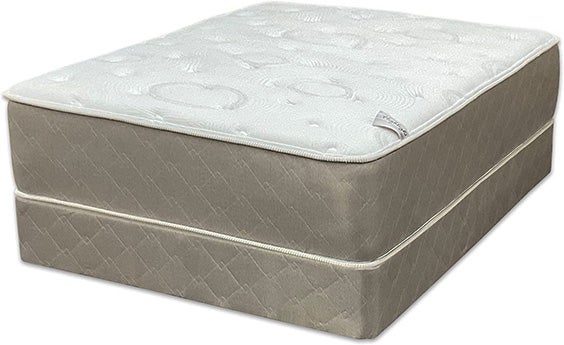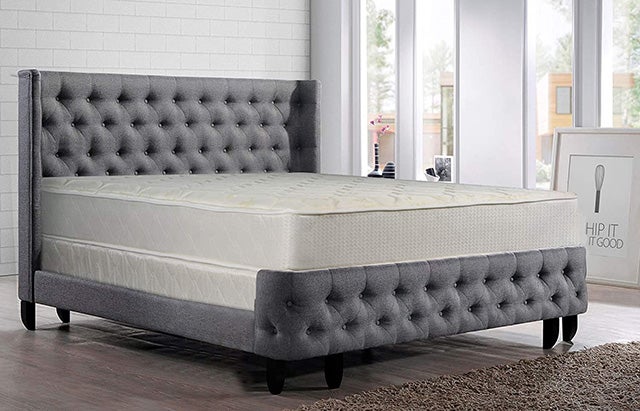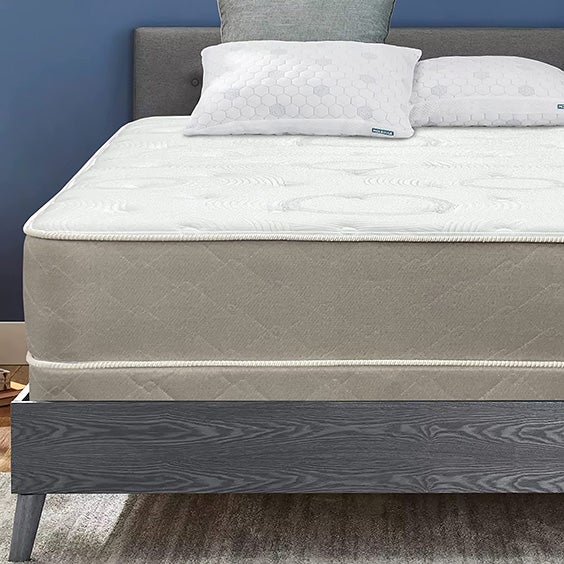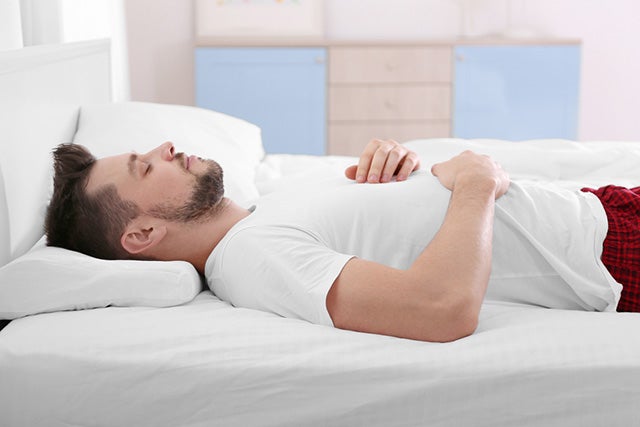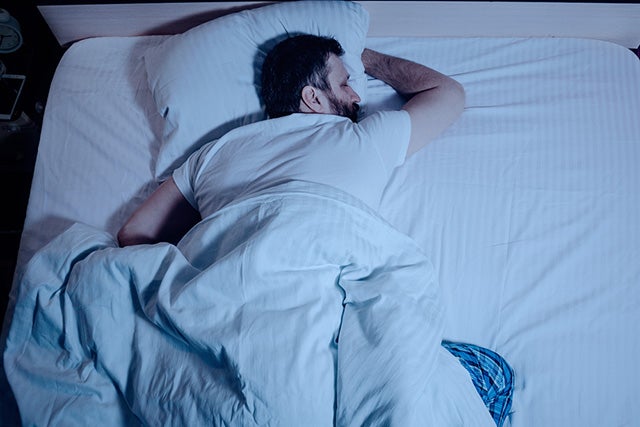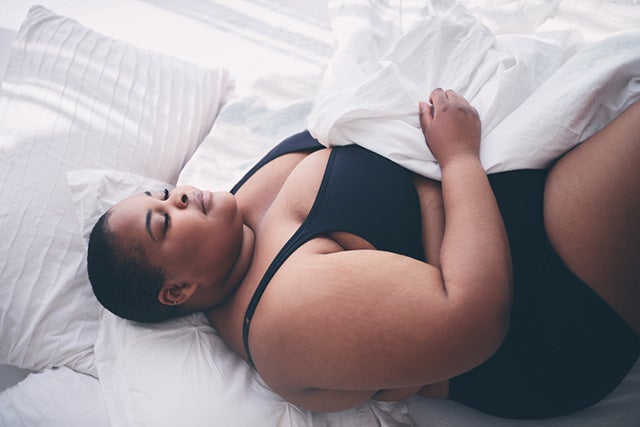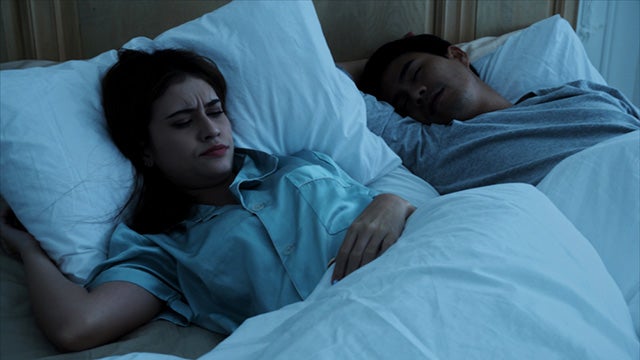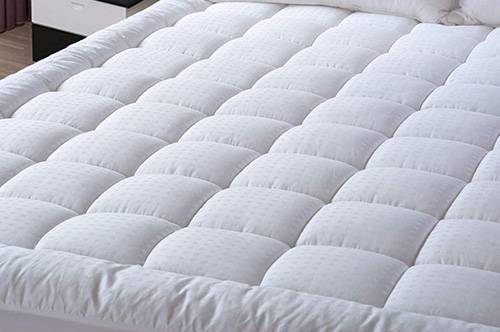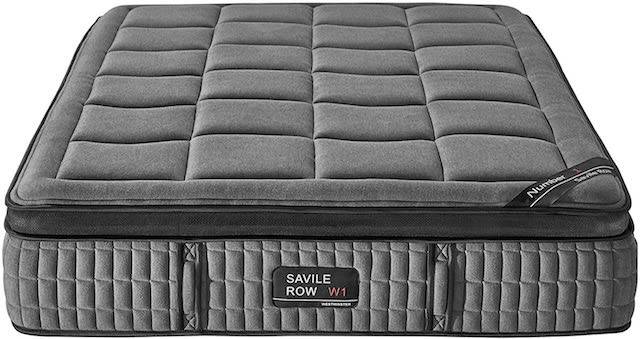On the market for a new mattress, but not sure about the nomenclature of your favorite choices? Knowing what features a mattress offers can help you narrow down which benefit you, and which might be best to avoid.
One of the most common, and highly influential, details is mattress top style. This can alter the overall feel of a mattress quite drastically, and is considered one of the driving comfort features of a mattress.
We explain the tight top mattress below, and provide who it is for, and who might want to avoid it. Take a look at our suggestions to help you find the best sleep possible.
What is a Tight Top Mattress?
Tight top beds is a type of innerspring or hybrid mattress type and refers to the type of initial surface offered by the bed. They are defined by a thick layer of upholstery-like fabric stretched tight across the top of the mattress. They can be made from cotton, polyester, bamboo, wool, or a blend to provide various cooling and comfort details.
Tight top surfaces may also come as a plush version that offers a thicker, slightly softer surface, but most provide a firm feel with minimal compression or contouring. However, they are more responsive overall compared to a pillow or Euro style top, and offer excellent cooling properties at a great price point.
You might want to check this out: The DreamCloud – Luxury Hybrid Mattress Review
Which Sleep Position is a Tight Top Mattress For?
Tight top surfaces are usually more “bouncy” and firm for many sleeper, but they have some excellent advantages you should consider.
• Back and Stomach Sleepers
Back and stomach sleepers need a firm surface to help keep their spinal column aligned. This type of mattress surface helps support the heavier parts of your body to avoid sinking and compromising your spine.
• Plus-Size Sleepers
Plus-size sleepers require a firmer surface to help support the body and avoid sink that causes spinal misalignment. Soft beds create discomfort and a tight top bed, especially one with a plush surface, works to cradle and support a heavier body.
You might be interested: The Best Mattresses for Heavy People
• Budget Friendly Needs
Tight top mattresses are also less expensive than other types of mattress top surfaces, making them a budget friendly option. They may lack overall durability, however, and wear out more quickly.
Who Should Avoid a Tight Top Mattress?
Side or combination sleepers should avoid this type of surface as a contour is needed to provide alignment to the shoulders and hips. Lightweight sleepers should also avoid the tight top as pressure points may form without enough body weight to create enough give where needed.
These types of beds often also have high motion transfer, so if you wake easily when your partner moves, this probably isn’t a good choice.
Other Types of Mattresses Tops to Consider
If a tight top mattress sounds like it might not be the best choice for you, you might want to consider a pillow top or Euro top. These options are more padded for contouring comfort.
• Pillow Top
A pillow top is a comforting, stitched later of plush, layered materials that sits on the top of the mattress. It offers a soft surface and works well with firm mattresses to provide relief from pressure points without sacrificing overall mattress support.
You might be interested: Best Pillow Top Mattress
• Euro Top
Euro top mattresses provide a layer of padding under the top of the mattress. This is a durable choice that provides a soft and contouring comfort. It also works well with a huge range of mattress support levels. This is usually the pricest top option.
Wrapping it Up
Tight top mattress is an affordable innerspring mattress choice that provides a firm sleep surface. Some options provide a bit of padded layering for pressure point relief as well.
These are great choices for anyone who needs a more firm surface for body comfort. Back and stomach sleepers, as well as plus-size sleepers will get the most out of this design.
Photo credit: AA.Shkob/Shutterstock; pixs4u/Shutterstock;
Olesia Bilkei/Shutterstock; Africa Studio/Shutterstock
Frequently Asked Questions
Mattress shopping raises many questions. Unsurprisingly, there is a lot of information you should consider before purchasing a new mattress. Take a look at these common questions relating to overall comfort and mattress comfort layer designs.
Can you Rotate or Flip a Tight Top Mattress?
Only mattresses that are double sided can be flipped. Most tight top mattresses are double sided, but always check with the care guide before doing so. All mattresses can be rotated, and should be to avoid contouring and sinks in one area of the mattress.
What is the Difference Between a Euro, Pillow, and Tight Top Mattress?
Euro tops are sewn under the top mattress layer, pillow tops are sewn over the top mattress layer, and tight top is a top layer pulled tight without added padded layers. All offer various comforts and are used with an innerspring mattress.
Is a Plush or Firm Mattress Better?
Medium firm to firm mattresses are considered the best choices for all sleepers. This is because they provide the support a body needs for proper spinal alignment. Changes in surface comfort and body contouring can be addressed with the different top layers you can choose from.
What is Better, a Foam or Innerspring Mattress?
This question is truly dependent upon personal preferences and body needs. Modern technologies have truly made these both a durable and comfortable choice. Many people prefer the firm support of an innerspring, but many foam designs now feel very much the same.
Foams may begin to take on contouring impressions and compression over time, but springs may do the same depending on the quality and weight of the sleeper.
Which Type of Mattress Lasts the Longest?
Latex foam mattresses are generally a gold standard for long lasting durability, but memory foam and innerspring, or innerspring hybrids all last about the same. Expect to get approximately 10 to 12 years out of most quality options.
